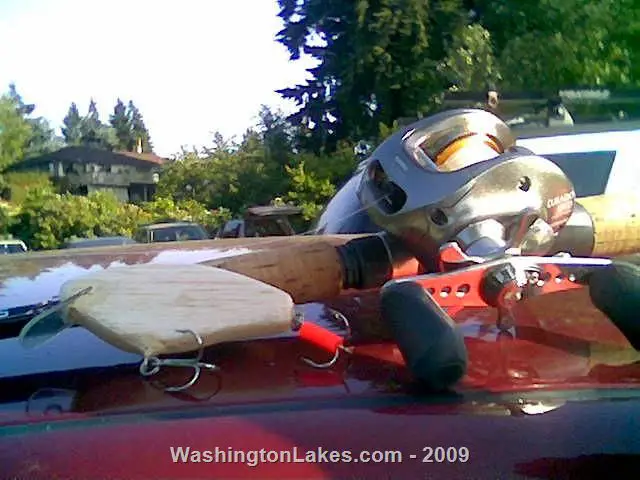Photos
Details
Another Crankin’ Story by IB 07-09-09
I recently started making my second crankbait. This one was made using the through-wire construction method, which I found to be a bit more challenging. I also decided to try a slightly different lip angle and use more weight to slow the rise of the crankbait, just to see what that would do.
I had to test the bait because I figured there would be no point in painting it if it didn’t work properly.
I got to the lake’s parking lot at 6:20 pm and was on the dock by 6:25 pm. I only had about 10 minutes to field test it. You ever have that feeling in your gut to use a certain technique (crankbaits) because you can feel it? Well, I was feeling it, that crankbaits were the ticket to the bass today, and I believed it with a warm and soothing confidence that could not be perceived or misconstrued as arrogance. No way. Just a gut feeling.
Buoyancy test: Passed. The bait dipped and rose to the surface and more slowly that the first crankbait. Check!
Wiggle test: Passed. It wiggled somewhat like the first crankbait, but it was less lively, probably a result of having put more lead into the body. This was a desired trait to achieve, to help me throw the bass or other fish a curve ball if they didn’t want a faster rising crankbait. Check!
Casting test: Passed. Like the first one, this crankbait casts very well and its extra weight helped it to cut through the air even better. Check!
During all of these tests, I engaged in pleasant banter with others on the dock. When they learned the lure was homemade, they thought it was pretty neat.
I don’t know what it is about field-testing my crankbaits, but I’m batting two for two if ever a five-minute mercy rule were imposed on me. I am now in full support of such a regulation. About five minutes after my first cast, I felt the bait get caught up on top of some grass. Doing what we bass anglers normally do, I ripped it free and felt a gentle take. It was definitely a take because grass doesn’t bite back.
I blurted, “Wow! I got one! Oh my gosh. I really got one! Yeah!!!!” as I reeled up some line and gently pulled the rod back. Never mind the disbelief of the folks on the dock next me as they peered over the rail to see for themselves. I couldn’t believe it. There I go again, shouting and laughing like I did last time, just embarrassing myself in public.
When she got close to the dock’s rail, I could see she was about a 2.75 lb. bass that was lightly hooked by one tip of a treble. I got her close enough for the folks to see her. Next, I let my line go slack so she could free herself, which she managed to do. I am glad she freed herself because if she couldn’t I would have had to reach through the rails to lip her and risk getting hooked and get the lovely fishy smell on my hands that doesn’t come off so easily and then the Mrs. will know I went fishing, yada, yada, and then get busted because I was supposed to come straight home, and never hear the end of it.
I made it home by 6:45 pm, in good time to start the grill up for dinner.
My poor bait is going to need some touching up. It appears that bass teeth can easily damage unprotected balsa.
Thanks again for coming along and sorry there’s no picture of the bass. My camera phone doesn’t take photo-worthy pictures anyway. There were many witnesses to boot. Goodness gracious! I still can’t get over catching a bass on an unpainted and unfinished crankbait.
-ib
Update: Someone suggested that the damage done to the bait might have been done by the trebles. I compare the spacing of the marks to those of the trebles and they are very close. I think it is reasonable to conclude that the damage was likely caused by the trebles instead of Ms. Bass. It did strike me as odd that bass teeth could do that but I was perplexed at that time. Thanks to Waterwings.
Comments
Why is this comment inappropriate?
Delete this comment? Provide reason.
